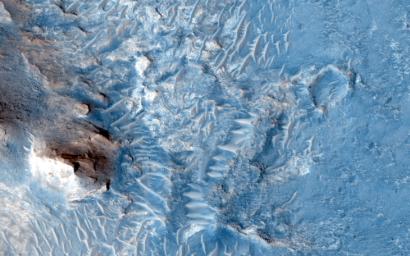
|
Ridges and a Valley with Flow Fronts
- Click the image above for a larger view
- Full-Res JPEG (2880 x 1800) (764.9 kB)
- Full-Res TIFF (2880 x 1800) (15.6 MB)
Caption:
In the area between Crommelin and Firsoff craters, we see heavily cratered terrain with deposits that record Martian geologic history and stratigraphy.
With HiRISE resolution, we might be able to decipher what materials are in the ridges of the inverted channels in this region and what the flows are: lava or sediment?
This caption is based on the original science rationale.
Background Info:
HiRISE is one of six instruments on NASA's Mars Reconnaissance Orbiter. The University of Arizona, Tucson, operates the orbiter's HiRISE camera, which was built by Ball Aerospace & Technologies Corp., Boulder, Colo. NASA's Jet Propulsion Laboratory, a division of the California Institute of Technology in Pasadena, manages the Mars Reconnaissance Orbiter Project for the NASA Science Mission Directorate, Washington.
Cataloging Keywords:
| Name | Value | Additional Values |
|---|---|---|
| Target | Mars | |
| System | ||
| Target Type | Planet | |
| Mission | Mars Reconnaissance Orbiter (MRO) | |
| Instrument Host | Mars Reconnaissance Orbiter | |
| Host Type | Orbiter | |
| Instrument | High Resolution Imaging Science Experiment (HiRISE) | |
| Detector | ||
| Extra Keywords | Color, Crater | |
| Acquisition Date | ||
| Release Date | 2013-05-22 | |
| Date in Caption | ||
| Image Credit | NASA/JPL-Caltech/Univ. of Arizona | |
| Source | photojournal.jpl.nasa.gov/catalog/PIA17732 | |
| Identifier | PIA17732 | |
